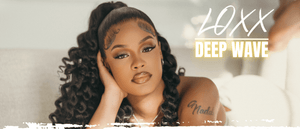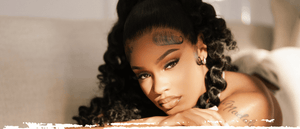The Ultimate Guide to Choosing Deep Wave Hair Wigs
Deep wave hair wigs offer a stunning, voluminous look with a natural wave pattern that suits various face shapes and styles. If you’re considering adding a deep wave wig to your collection, here’s everything you need to know about selecting the perfect one to fit your look and lifestyle.
1. Understanding Deep Wave Hair Texture
Deep wave wigs are known for their luxurious texture and close, defined waves. This texture falls between curly and wavy, providing a full-bodied appearance that works well for both casual and formal styles.
- Benefits of Deep Wave Texture: The deep wave pattern is versatile, allowing for effortless styling while maintaining a voluminous look. Unlike loose waves, deep waves offer a more defined curl, creating a fuller appearance.
- Choosing Based on Face Shape: Deep wave wigs are flattering on various face shapes. For round or oval faces, medium-length deep wave wigs add structure, while longer lengths suit square and heart-shaped faces by softening angles.
2. Human Hair vs. Synthetic Deep Wave Wigs
Deciding between human hair and synthetic options is a crucial first step in selecting the right wig. Both have unique advantages depending on your styling needs and budget.
- Human Hair Deep Wave Wigs: These wigs look and feel natural, can be heat-styled, and last longer with proper care. They offer versatility, allowing for curling, straightening, or even coloring to customize the look. However, they come at a higher price point due to their quality and durability.
- Synthetic Deep Wave Wigs: Synthetic wigs are generally more affordable and come pre-styled, holding their deep wave pattern without the need for restyling after washing. While they’re lower maintenance, they can’t be heat-styled like human hair wigs, which limits versatility.
3. Selecting the Right Length and Density
Length and density play a significant role in achieving the style you want with your deep wave wig.
- Choosing Length: The length of your wig impacts both styling options and maintenance needs. Shorter lengths (10-14 inches) are easier to care for and offer a subtle, natural look, while longer lengths (16 inches and above) provide a more dramatic, glamorous style.
- Optimal Density: Wig density determines the fullness of your deep wave wig. Standard density ranges from 130% to 150%, creating a natural look that’s neither too full nor too thin. For those seeking a fuller, voluminous look, consider densities of 180% or higher, especially if you’re opting for longer lengths.
4. Choosing the Right Lace Type
Lace type impacts the wig’s appearance, comfort, and how natural it looks at the hairline. Here are the main types to consider:
- Lace Front Wigs: Lace front wigs are popular for their natural hairline appearance and versatility in parting. They are comfortable for daily wear and provide a seamless look at the front.
- Full Lace Wigs: Full lace wigs allow for parting and styling versatility across the entire scalp, making them ideal for updos and ponytails. However, they require more maintenance and are usually higher in cost.
- 360 Lace Wigs: These wigs feature lace around the entire perimeter, combining the benefits of lace fronts and full lace. They allow for natural-looking ponytails while remaining secure and comfortable.
5. Color Choices for a Natural or Bold Look
The color of your deep wave wig can either blend with your natural shade or make a statement. Here’s how to decide:
- Natural Colors: Shades like natural black, dark brown, and chestnut blend seamlessly for a more natural look. They suit most skin tones and provide an everyday, understated elegance.
- Bold Colors and Highlights: For a more dynamic look, consider deep wave wigs with highlights, ombré, or balayage effects. Shades like honey blonde or auburn add dimension and are ideal if you’re looking to make a statement.
6. Styling and Maintenance Tips
Maintaining the beautiful wave pattern of your deep wave wig requires specific care to ensure longevity and prevent frizz or tangling.
- Detangle with Care: Use a wide-tooth comb or your fingers to detangle, working from the ends toward the roots. Avoid brushing, as it can disturb the curl pattern and cause frizz.
- Hydration and Conditioning: Deep wave wigs, especially human hair, need regular conditioning to keep them soft and hydrated. Use a sulfate-free conditioner after washing to maintain the curl pattern.
- Styling Products: Use lightweight styling products designed for curly or wavy hair to enhance the deep wave texture. Avoid heavy oils or creams, as they can weigh down the waves and cause buildup.
- Heat Styling Caution: If you have a human hair deep wave wig, limit the use of heat styling tools to prevent damage. If heat styling is necessary, always apply a heat protectant spray.
7. Buying Tips: Ensuring Quality and Authenticity
Purchasing a high-quality deep wave wig requires careful attention to sourcing and authenticity, especially if you’re investing in human hair.
- Check Reviews and Supplier Reputation: Buying from reputable brands with positive reviews can ensure the wig's quality and durability. Verified customer photos and feedback provide insight into the wig’s performance and longevity.
- Ask About Hair Origin: If you’re purchasing a human hair wig, inquire about the origin and quality grade. High-quality human hair, such as Remy hair, is cuticle-aligned, making it soft, tangle-resistant, and long-lasting.
Final Thoughts
Choosing the perfect deep wave wig involves considering the right texture, type, length, and color to match your personal style and lifestyle. Whether you’re opting for a natural look or something bold, understanding your options helps ensure your wig enhances your beauty and confidence.



